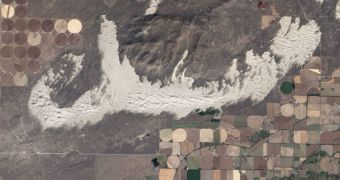A new series of scientific observations, carried out from aboard a satellite, have revealed some interesting clues to the history of a series of dunes that mark the landscape in the state of Idaho.
For most people, the landscape is nothing more than a good view, at times, and a daily occurrence at other times. Very few people stop to think that the ground in front of their eyes most likely has a story to tell.
But geologists and planetary scientists can derive a lot of data on an area, spanning back millions of years at times, by simply looking at the landscape features that exist around.
Sampling them provides their studies with even more information, such as what type of events triggered the formation of a valley, hill, mountain and so on.
While looking at the satellite images covering Idaho’s Snake River valley, researchers were able to do the same. A large series of sand dunes adorn the landscape here, but people often tend to disregard them.
Preliminary results of a study covering the area shows that the dunes were most likely formed at the end of the last Ice Age, which took place some 10,000 years ago.
The area that is currently eastern Idaho began to warm up as the glacial maximum receded, and all lakes in the area started to get smaller.
This exposed an eroded chain of former volcanoes to the elements, the researchers say. As powerful winds blew past, they carried sediments that eventually started getting deposited at the base of the volcanoes.
This slow process continued for millennia, with the end result being this series of sand dunes that apparently came out of nowhere. Their crests still show the direction in which the ancient wind was blowing.
The recent investigation was carried out from the EO-1 satellite, which is operated by the American space agency. The spacecraft is a part of the New Millennium Program (NMP).
“A sense of time is the most important thing to get across to a non-geologist,” explains University of California in Davis (UCD) tectonics expert Eldridge Moores, quoted by Wired.
“A million years is a small number on the geological time scale, while human experience is truly fleeting – all human experience, from its beginning, not just one timeline,” he concludes.

 14 DAY TRIAL //
14 DAY TRIAL //